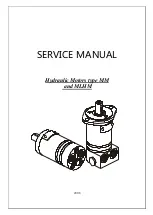
Maintenance of Major Components
- 107 -
z
The engine speed signal is usually obtained from a magnetic speed sensor mounted in close
proximity to the teeth of a ferrous ring gear that is driven by the engine. The frequency of the speed
sensor signal is proportional to the engine speed. The speed control unit will accept any signal if the
frequency is proportional to engine signal, and in the frequency range of the speed control unit (1 K to
7.5 K Hz.). The speed sensor is typically mounted in close proximity to an engine driven ferrous gear,
usually the engine ring gear. As the teeth of the gear pass the magnetic sensor, a signal is generated
which is proportional to engine speed. The signal strength must also be within the range of the input
amplifier. An amplitude of 1 to 120 volts RMS is required to allow the unit to function within its design
specifications. The speed control unit has an input impedance of 20 K-ohms between the speed
sensor input terminals. (“C” & “D”). Terminal “D” is connected internally to the battery negative. Only
one end of the shielded cable should be connected.
z
When a speed sensor signal is received by the controller, the signal is amplified and shaped by an
internal circuit to form constant area pulses. If the speed sensor monitor does not detect a speed
sensor signal, the output circuit of the speed control unit will turn off all current to the actuator.
z
The summing point of the speed sensor and the speed adjust control is the input to the dynamic
control section of the governor. The dynamic control circuit, of which the gain and stability
adjustments are part, has a control function that will provide isochronous and stable performance for
most engine types and fuel systems.
z
The speed control unit circuit is influenced by the gain and stability performance adjustments. The
governor system sensitivity is increased with clockwise rotation of the gain adjustment. The gain
adjustment has a non-linear range of 33:1. The stability adjustment, when advanced clockwise,
increases the time rate of response of the governor system to match the various time constants of a
wide variety of engines. The speed control unit is a PID device, the “D”, derivative portion can be
varied when required.(See Instability section.)
z
During the engine cranking cycle, STARTING FUEL can be adjusted from an almost closed, to a
nearly full fuel position. Once the engine has started, the speed control point is determined, first by
the IDLE speed set point and the SPEED RAMPING circuit, After engine speed ramp- ing has been
completed, the engine will be at its governed operating speed. At the desired governed engine
speed, the actuator will be energized with sufficient current to maintain the desired engine speed,
independent of load (isochronous operation).
z
The output actuator current switching circuit provides current to drive the actuator. The output
transistor is alternately switched off and on at a frequency of 300 Hz. which is well beyond the natural
frequency of the actuator, hence no visible motion from the switching results. Switching the output
transistors reduces its internal power dissipation for efficient power control. The output circuit can
provide current of up to 10 amps continuous at 25 C for 24 VDC battery systems. The actuator
responds to the average current to position the engine fuel control lever.
z
In standard operation, the speed control unit performance is isochronous. Droop governing can be
selected by connecting terminals K & L and the percent of droop governing can be varied with the
droop adjustment control. The droop range can be decreased by connecting Terminals G and H.
z
The speed control unit has several performance and protection features which enhance the governor
system. A speed anticipation circuit minimizes speed overshoot on engine startup or when large
increments of load are applied to the engine.
Summary of Contents for P158LE -III
Page 160: ...Appendix 157 1 P158LE Generator engine assembly EH5OM013 ...
Page 161: ...Appendix 158 2 P180LE Generator engine assembly EH5OM014 ...
Page 162: ...Appendix 159 3 P222LE Generator engine assembly EH5OM015 ...
Page 163: ...Appendix 160 4 PU158TI Power unit engine assembly EH5OM016 ...
Page 164: ...Appendix 161 5 PU180TI Power unit engine assembly EH5OM017 ...
Page 165: ...Appendix 162 6 PU222TI Power unit engine assembly EH5OM018 ...
















































